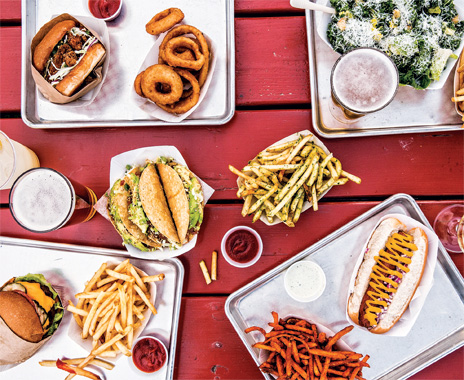As a growing slice of consumers look for fast, affordable, and quality meals, the quick-service industry is uniquely positioned to fill such a need. At the same time, widespread calls to make fast food healthier have put some chains at a crossroads where they grapple to improve quality without sacrificing a brand identity designed around value.
Following the lead of progressive fast-casual brands built on messages of healthier, more wholesome foods, some limited-service brands are looking to better sourcing quality as a solution—swapping conventionally grown fruit and veggies for organic, sourcing humanely raised meat, and pulling artificial flavors and colors from ingredient decks. Meanwhile, others argue that the correct way to offer health is to focus first on creating more nutrient-dense menus.
“There’s no question that as Americans and worldwide, we need to be focusing more on nutrient quality first,” says Anita Jones-Mueller, president and founder of Healthy Dining Finder. “From there, we can start looking at sourcing quality, like organic, locally sourced, and additive-free. It’s a little backwards right now, where we’re focusing on the quality first. Organic junk food is not where the future is.”
Jones-Mueller says that with nutrition becoming among the biggest drivers in how people choose restaurants, chains should be most concerned with building a healthy legacy rather than relying on less nutritious offerings that fostered loyalty in the past.
Moreover, whether through education or simply more regular exposure to healthier foods, consumers are more “ready” for nutty whole-grain buns and brown rice instead of their refined counterparts, and they are OK with occasionally swapping fries for a salad or beef for a chef-driven veggie patty, she says.
Sixteen-year-old California burger chain Gott’s Roadside is best known for its burgers, fries, and shakes, but brand manager Ann Pepi says that healthy alternatives like fish tacos, ahi tuna burgers, and salads have always been part of the core concept. Having previously offered veggie and turkey burgers as standalone items, both are now listed as alternatives to beef, which makes the healthier protein decision a quick and easy one.
“It’s about offering a balance of indulgent and lighter, healthier options, but also giving people things they will actually order and eat,” she says. “We do have to remain true to what we’re known for, and in the end for us that’s our beef burgers. But we want people to realize if they do go with beef, that we use better ingredients.”
Pepi acknowledges the importance of nutrient-dense offerings and says Gott’s continues to add healthier sandwiches like grilled chicken with avocado and plans to create healthier kids’ options. Gott’s also embraces better-quality sourcing where it resonates with the brand and customers. It switched to Niman Ranch antibiotic- and added hormone–free beef and antibiotic-free Mary’s Free Range chicken about five years ago, and more recently to Three Twins’ organic ice cream and milk.
“We try and make big stands where it’s important to us and customers,” she says. “That’s the way things are going, and we have to be ahead of the curve to stay relevant.”
Customers of Atlanta-based chicken sandwich chain Chick-fil-A—along with restaurant intercepts, taste panels, and industry research—helped it prioritize where and when to make health-related changes, says director of menu strategy Paul Trotti.
“The three things our customers are most focused on right now are cleaner ingredients, freshly prepared food, and nourishing choices,” he says. “Taste used to be No. 1, but there’s been a mindset shift toward health and wellness in this country, so it’s now taste and health.”
Such concerns have spurred the chain to reduce sodium menu-wide, pull artificial colors and high-fructose corn syrup from sauces and salad dressings, revamp its salads, and up the frequency of produce deliveries to three times a week. It also invested roughly $40 million and tested 1,000 recipes over the past few years to perfect its grilled chicken recipe.
Perhaps its most ambitious move yet has come on the quality front, however, with last year’s announcement of a five-year commitment to remove all antibiotics from its chicken supply. Given Chick-fil-A’s core offerings, Trotti says, it was an easy issue for the brand to get behind. The team is about 23 percent through this goal as it balances scaling supply and maintaining quality.
For Subway, accommodating multifaceted health-related concerns comes down to choice and affordability. From heeding calls to remove hot-button ingredients like high-fructose corn syrup (as of December 2014) and artificial colors and flavors (89 and 79 percent removed, respectively, from Subway menus as of December 2015) to creating a dedicated Fit Fresh Menu and upping the whole grains in its bread, the brand aims to reach the health-minded, the food-as-fuel consumer, and everyone in between.
“You have to remember, the lens of ‘fit’ food is different for every customer,” says Elizabeth Stewart, director of corporate responsibility. By quietly reducing overall sodium levels steadily since 2009 and making spinach a core topping offering, Stewart says, Subway helps even those who aren’t making as conscious of an effort to get healthier do so. And as health and wellness increasingly permeate all aspects of life, quick-service restaurants are where the rubber meets the road, Jones-Mueller says.
“Quick service already fills a huge need in the American lifestyle to grab food quickly,” she says. “For them to take that need and start transitioning it so we’re also able to quickly grab food that’s healthy, [quick service] is right in the right place to do it.”











